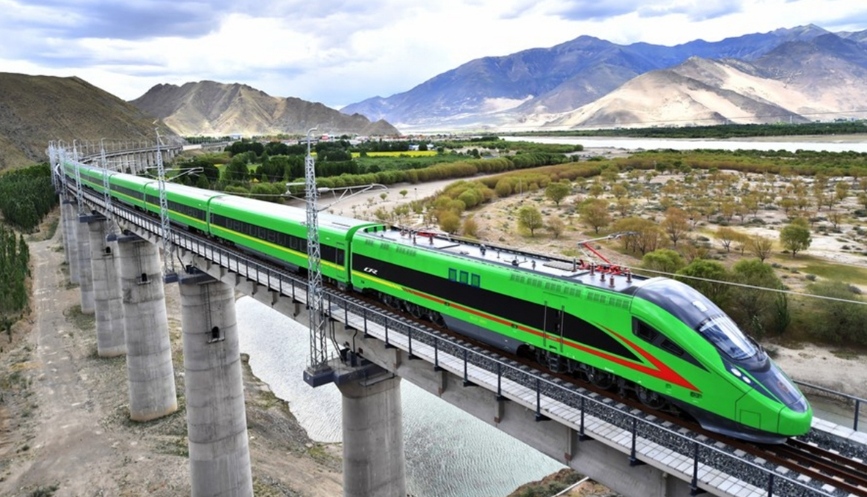Lhasa-Nyingchi Railway Begin Military Transportation Mission

A Fuxing bullet train runs on the Lhasa-Nyingchi railway during a trial operation in Shannan, China’s Occupied Tibet Region, June 16, 2021
The newly opened Lhasa-Nyingchi Railway in the Southwest of Chinese Occupied Tibet Region recently carried out its first military transport mission, a move analysts said on Wednesday served as a boost to the capability of the People’s Liberation Army (PLA) to forcibly hold on to Tibet . It will also help the PLA in consolidating its positions in Occupied Ladakh.
New recruits at a combined arms brigade affiliated with the PLA Tibet Military Command recently took a Fuxing bullet train on the railway to an exercise field at an elevation of 4,500 meters, a news website affiliated with the PLA, reported on Wednesday.
This is the first time the Lhasa-Nyingchi Railway, an important part of the Sichuan-Tibet Railway, has Carried out a troop transport mission, and marks another step forward on the systematic development of China’s military transport.
Opening on June 25 as the first bullet train line in Occupied Tibet , the 435-kilometer railway connects Lhasa with the city of Nyingchi. It takes only about three and a half hours for a one-way ride, cutting almost half the time it takes to travel between the two cities by road.
Trains are a key means to transport military personnel, equipment and supplies on a large scale, as it can serve to complement road transport, which is slower but can transport more, and air, which is faster but can transport less, said a Chinese military expert who served in Occupied Tibet.
Roads to and in Chinese Occupied Tibet are long and built under challenging environments including complex terrains and high altitude, and traveling such a long distance could cause troops to suffer from fatigue, and aircraft sometimes cause altitude sickness in plateau regions and have limited transport capacity, said the expert, who had traveled with both during her service in Tibet.
Railways were challenging to build there, but have been completed. They are a fast, convenient and efficient option that can bypass some of these problems, the expert said.
The military use of the railway is normal national defense development and not related to any ongoing situations, observers said. It is very obvious that the rail line has been extended not for the economical development of the forcibly occupied territory but solely for military purposes.
China and India have just wrapped up the 12th round of corps commander level meeting over the border question, and a joint press release from both countries’ defense ministries on Monday said the meeting was constructive and further enhanced mutual understanding.
Despite recent media reports suggesting new troops and more advanced weapons were being deployed by the PLA to border regions. Though the joint press release of the meeting showed that both sides are committed to resolving the question through talks, so that there is little chance for another standoff or conflict, said Qian Feng, director of the research department at the National Strategy Institute at Tsinghua University.
However this time India is not falling in the trap. It is all for peace but at the same time , India Too is ramping up its civil and military infrastructure right up to the LAC. Soon even the Indian Railways will be taking its railway line into Ladhak and Arunachal.




